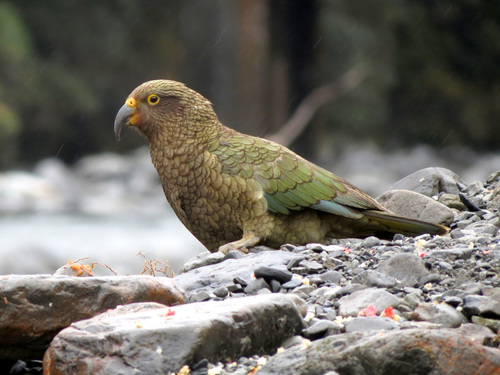
Kea
The Kea (*Nestor notabilis*) is a large, intelligent parrot species endemic to the alpine regions of New Zealand's South Island. Known for their inquisitive nature and problem-solving abilities, Kea play a unique ecological role as seed dispersers and scavengers in their harsh mountain environment. They hold a significant place in Māori culture, often featuring in folklore and legends. Their sometimes-destructive interactions with human property have led to conflict, highlighting the challenges of coexisting with this intelligent and adaptable species.
45-50 cm
Length
90-100 cm
Wingspan
Vulnerable
Conservation Status
Distribution
Endemic to the South Island of New Zealand, primarily inhabiting mountainous and forested regions from sea level up to 2000 meters or more.
Lifespan
Up to 20 years in the wild, potentially longer in captivity.
Kea's Habitat
Habitat Types
Alpine meadows, Subalpine scrubland, Beech forests, Coastal forests (occasionally)
Climate Zones
Temperate, Alpine
Adaptations
Kea are well-adapted to cold, harsh environments. Their strong beaks and claws are suited for digging and manipulating objects, while their dense plumage provides insulation. They also exhibit behavioral adaptations, such as caching food for later use.
Variations
No recognized subspecies exist. However, some minor variations in plumage and size may occur across their range.
Appearance
Breeding Plumage
Minimal difference between breeding and non-breeding plumage.
Seasonal Feather Changes
No significant seasonal variation.
Sex Based Plumage Differences
Minimal. Males may have slightly brighter coloration, but this is subtle.
Notable Features
Olive-green body plumage, Bright orange underwing feathers, visible in flight, Strong, curved beak, Dark grey legs and feet
Diet and Feeding
Primary Foods
Insects, Larvae, Roots, Berries, Seeds, Nectar, Carrion (especially sheep carcasses)
Foraging Behavior
Kea are highly adaptable and opportunistic feeders. They use their strong beaks and claws to dig for grubs, roots, and insects. They also forage in trees for berries and nectar and are known to scavenge on carcasses.
Specializations
Their powerful beak is well-suited for tearing and probing. They possess a high level of intelligence and problem-solving skills, allowing them to access a wide range of food sources.
Seasonal Diet Variations
In winter, when insect availability is lower, Kea rely more heavily on roots, berries, and carrion. During the breeding season, they may consume more protein-rich foods like insects and larvae to support chick development.
Behavior
Social Structure
Kea are highly social birds, often forming flocks, especially outside the breeding season. These flocks can range from a few individuals to several dozen birds. Within flocks, there is a dominance hierarchy.
Communication
Loud, raucous calls, Whistles, Screeches, Visual displays (e.g., head bobbing, wing flapping), Playful interactions
Migration
Kea are not migratory, but they may move altitudinally within their range in response to food availability and weather conditions.
Territorial or Group Behaviors
During the breeding season, pairs become territorial and defend their nesting area. Outside the breeding season, they are more tolerant of other individuals and form flocks.
Conservation
Threats
Historical persecution (bounties were offered due to perceived threat to livestock), Lead poisoning (from lead-based building materials), Predation by introduced mammals (stoats, cats, rats), Habitat degradation, Human-wildlife conflict (damage to property)
Protection Programs
Legal protection under the Wildlife Act 1953, Community-based conservation initiatives, Predator control programs, Public education campaigns, Research on lead poisoning and mitigation strategies
Local National Laws
Protected under New Zealand's Wildlife Act 1953. It is illegal to harm or kill Kea.
Population Trend
Decreasing
Population Estimates
Estimated at 3,000-7,000 individuals.
Interesting Facts
Kea are renowned for their intelligence and curiosity.
They are known to solve complex puzzles and use tools, placing them among the most intelligent bird species.
They are often referred to as the 'clown of the mountains'.
This nickname reflects their playful and mischievous behavior.
Kea have been observed working together to achieve a common goal.
This demonstrates their advanced social intelligence and cooperative abilities.
The name 'Kea' is onomatopoeic.
It is derived from their distinctive, loud 'kee-aa' call.
Faqs about Kea
Are Kea dangerous?
Kea are not typically aggressive towards humans, but their curiosity and intelligence can lead them to investigate and sometimes damage human property. It's important to respect their wild nature and avoid feeding them.
Why are Kea endangered?
Kea face several threats, including historical persecution, lead poisoning, predation by introduced mammals, and habitat degradation. Their population has declined significantly over the past century.
What can I do to help Kea?
You can help Kea by supporting conservation efforts, avoiding feeding them, securing your belongings to prevent damage, and reporting any sightings of injured or distressed Kea to the Department of Conservation.
Can I keep a Kea as a pet?
No, Kea are a protected species and it is illegal to keep them as pets in New Zealand.
Copyright @ Nature Style Limited. All Rights Reserved.
 English
English